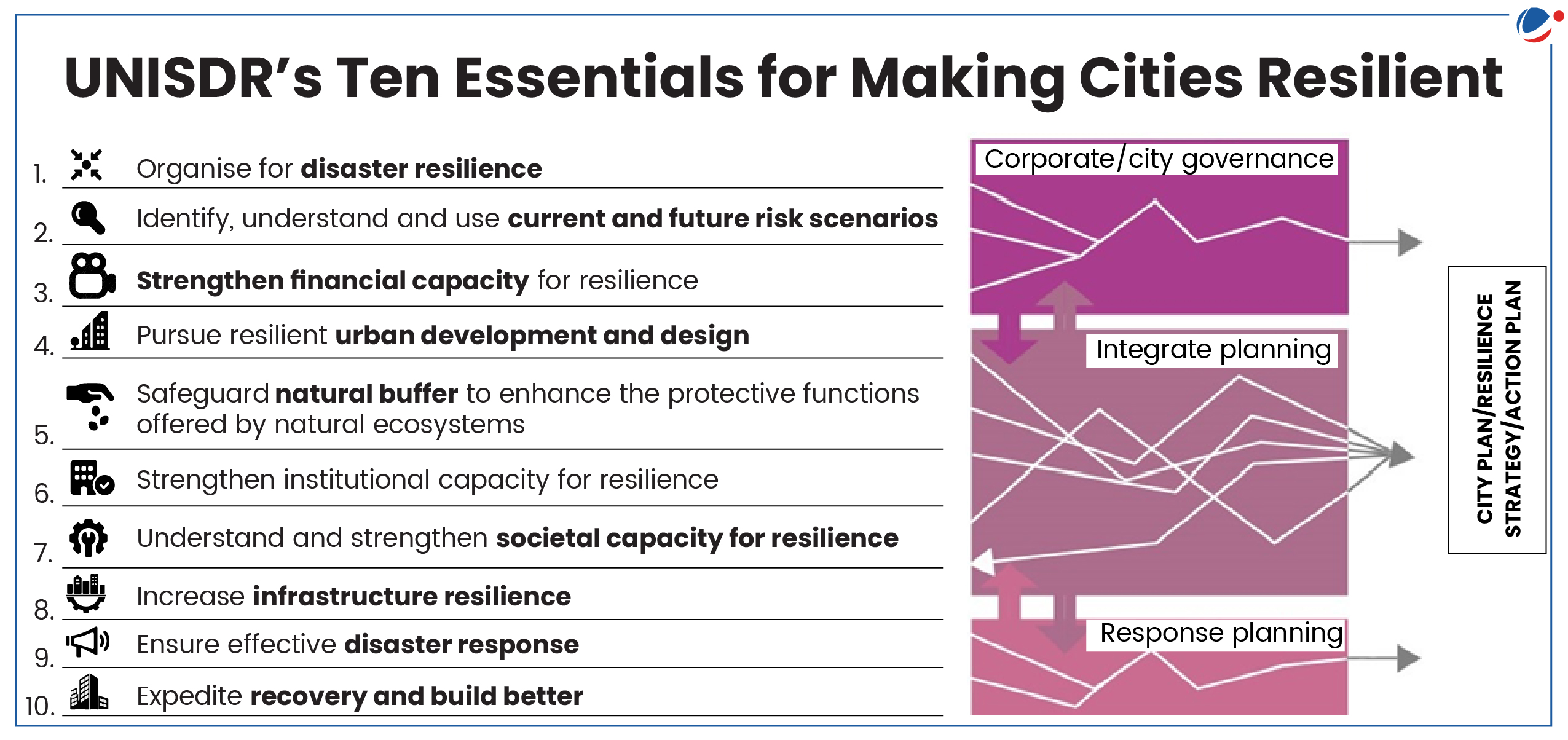Why in the news?
Rising frequency of various disasters, especially in Monsoon season, have brought to fore the unpreparedness of Indian cities to deal with disasters and seasonal extremities.
Vulnerability of Indian Cities
- Population Centers: Over 30 percent of India already resides in cities—a number which is projected to grow to 40 percent by the year 2030.
- By its very nature of population concentration and developmental densities, urban areas give birth to risks.
- Unplanned urbanization: The growth of urbanization in India has been largely unplanned, leading to both environmental and resource degradation.
- According to a paper by the National Institute of Urban Affairs (NIUA), megacities like Chennai, Kolkata, and Mumbai had already reached their maximum threshold for environmental degradation before 2014.
- Climate Change: Climate change puts further strain on infrastructure with increase in frequency and intensity of climate related disasters such as heatwaves, urban floods, cyclones etc.
- In August 2023, torrential rains in Shimla and Solan district of Himachal Pradesh triggered landslides, flash floods and cloudbursts, disrupting lives and livelihoods.
- Existing Vulnerabilities: Various vulnerabilities already exist in urban setting such as urban poverty, extent of informality in urban employment, social inequality etc.
What is a Disaster Resilient City?
As per National Institute of Disaster Management, a disaster resilient city:
- Is one where sensible building codes are followed and informal settlements are not built in vulnerable areas such as flood plains or steep slopes.
- Has an inclusive, competent and accountable local government focusing on sustainable urbanization.
- Is one where a shared, local information base on disaster losses, hazards, risks and vulnerability of populace is maintained.
- Is one where people are empowered to participate, decide and plan their city together with local authorities and value local and indigenous knowledge, capacities and resources.
- Has taken steps to anticipate and mitigate the impact of disasters, incorporating monitoring and early warning technologies to protect infrastructure, community assets and individuals.
- Is able to respond, implement immediate recovery strategies and quickly restore basic services to resume social, institutional and economic activity after such an event.
Initiatives/Mechanisms for developing urban disaster resilience
- Governance: Disaster Management Act, 2005, and institutions under it including National Disaster Management Authority, State Disaster Management Authorities and National Disaster Response Force.
- National Policy on Disaster Management 2009 envisions to build a safe and disaster resilient India by developing a holistic, proactive, multi-disaster oriented and technology driven strategy.
- National Disaster Management Plan (NDMP) 2016 provides a framework and direction to the government agencies for all phases of disaster management cycle.
- Urban Local Government (ULG): Urban local governments have critical roles and responsibilities in building resilience to climate change and related disasters.
- Such responsibilities include setting and enforcing building codes, land use regulations, urban planning and zoning, basic infrastructure, fire protection, healthcare and emergency planning and response etc.
- Government Schemes: Schemes such as Atal Mission for Rejuvenation and Urban Transformation (AMRUT), Housing for All (Urban) Scheme and the Smart Cities Mission focuses on making cities smart, sustainable, inclusive and livable while promoting economic growth.
- Climate Smart Cities Assessment Framework: It consists of indicators across five categories namely: urban planning, green cover and biodiversity; energy and green buildings; mobility and air quality; water management; and waste management.
- Union Budget 2024-25: The Budget has also proposed encouraging electric bus systems for cities and has provided ₹1,300 crore for it. E-buses offer an economical and eco-friendly operating system, but the main challenge is their higher upfront cost. However, this budgetary support may get the ball rolling.
Challenges in building disaster resilience in Indian cities
- Lack of planning: According to the NITI Aayog, 65 percent of Indian cities currently do not have a master plan. Even the city master plans are not sufficiently addressing the issue of climate change.
- Governance issues: Political influence on decisions for location for infrastructure development leads to uncontrolled construction in disaster-prone zones which heightens the risk of natural and anthropogenic disasters.
- Concretization: Urban spaces are increasingly being covered with concrete and asphalt at the expense of green spaces turning them into heat sinks.
- This phenomenon is also known as Urban Heat Island, and it further exacerbates climate extremities and increases risk factor.
- Crumbling Infrastructure: Sewerage and drainage systems in most Indian cities is inadequate to cope with heavy rainfall, causing water logging and flooding in Indian cities in every monsoon season.
- Insufficient health infrastructure: There is a lack of strong quick response system that is required in times of crisis. Health infrastructure is in critical need of funds, investments, staff, equipment and quality service delivery.
- Departmentalization in functioning: Departments often operate in silos focusing on resources such as water, transport, energy, etc. independently, which further complicates outcomes.
- Lack of private funding: According to the Global Infrastructure Hub, private funding has remained stagnant in the last few years while the infrastructure funding gap has reached multi-trillion-dollar figures.
Way Forward
- Governance: Disaster management should be devolved to municipalities, and functionaries need to be properly empowered for efficient implementation of plans and discharge of duties.
- Finance: Climate finance can be mobilized by creation of a land banks (owned by the municipalities) and leasing of properties to commercial organizations.
- The option of Corporate Social Responsibility (CSR) funding also needs to be explored.
- Public-Private Partnerships (PPPs) will be essential in addressing the funding needs of low-carbon and energy-efficient development.
- Participatory Planning: Future planning and reforms should be participatory in nature and consider the informality and vulnerabilities that are prominent in Indian cities.
- In Japan, for example, the disaster management agencies work with communities to generate awareness about things to do at the time of a disaster.
- Nature Based Developments: Natural hazards will not result in disasters if natural products are used in built structures.
- For instance, in the mountainous state of Uttarakhand, most fatalities were noted among people living in concrete structures.
- Greening of public and private spaces: Creation of multiple small patches of green space at various places in cities will be useful in managing microclimate, as against developing a few vast patches.
- Green mobility: A shift to green mobility in public transport is urgently needed for maintaining a good environment.
- Knowledge Management Networks: Cities need to create and utilize knowledge management frameworks which require comprehensive data collection to understand hyperlocal needs and challenges.
- Resources can be used most efficiently and sustainably with location-specific knowledge, which is best generated and understood locally.









